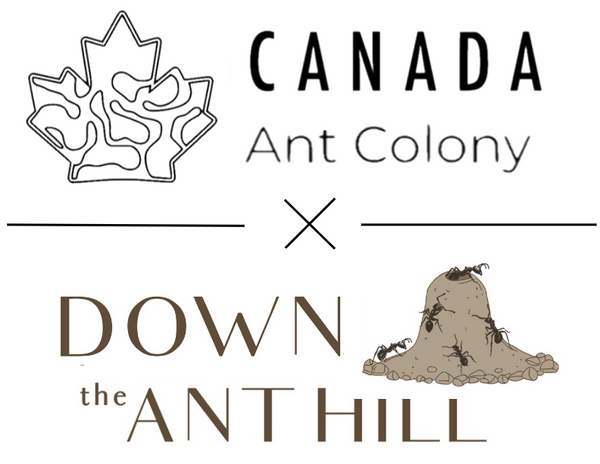If you're gearing up for a science fair and searching for fresh ideas, look no further than these 12 unique science fair ideas for biology students!
While classic projects like the vinegar volcano have their charm, it's time to think outside the box and explore the fascinating world of biology. From studying plant growth to investigating the behavior of insects, these biology-themed projects will help you stand out and make the most of your science fair experience.
For any help on insect or ant related projects, Browse our kits and colonies to get started with an ant colony today.
Featured image credit to Mohamed Babu
1. The Effects of Vinegar on Ant Communication

Ants communicate via chemicals, called pheromones, and by tapping each other with their antennae
- Description: Investigate how rubbing a surface with vinegar, or other household chemicals (e.g. rubbing alcohol, bleach) affects ants' ability to recruit friends to a food source.
- Purpose: Understanding how common household products can interact with the ants' chemical communication.
2. The Effects of Caffeine on Plant Growth

- Description: Investigate how varying levels of caffeine affect the growth rate of plants. Compare the growth of plants watered with caffeinated solutions versus plain water.
- Purpose: Understanding how substances like caffeine, commonly consumed by humans, can impact plant life and potentially the environment.

3. Bacteria and Hand Hygiene: Which Method Works Best?
- Description: Test the effectiveness of different hand-washing techniques and sanitizers by measuring bacterial growth on agar plates before and after washing with soap, hand sanitizer, and just water.
- Purpose: To determine the most effective way to eliminate bacteria on hands, relevant to public health.
4. The Role of Light Color on Photosynthesis
- Description: Explore how different colors of light (red, blue, green, etc.) affect the rate of photosynthesis in plants by measuring oxygen production or starch accumulation.
- Purpose: To understand how light wavelengths impact plant growth and the process of photosynthesis.

5. The Microbiome of Different Environments
- Description: Compare the bacteria and fungi found in various locations, such as homes, parks, and schools. Swab surfaces, grow cultures on agar plates, and identify the diversity of microbial life in different environments.
- Purpose: To raise awareness of the unseen world of microbes in our daily environments.

6. Ant Traffic Jams
- Description: Provide a colony of ants a source of food over a bridge. Vary the width of the bridge, and see how ants manage traffic jams by measuring the density and speed of the workers on the bridge at each bridge size.
- Purpose: To explore how other organisms and societies deal with problems like traffic.
7. The Impact of Acid Rain on Aquatic Life
- Description: Simulate acid rain by using vinegar or other acidic solutions to test its effects on small aquatic ecosystems like fish tanks or containers with aquatic plants and algae.
- Purpose: To demonstrate how environmental pollutants affect water quality and aquatic organisms.
8. Testing the Effectiveness of Natural Antibiotics
- Description: Examine the antibacterial properties of natural substances like garlic, honey, and ginger by testing their effects on bacterial cultures. Compare them with conventional antibiotics.
- Purpose: To explore alternative solutions to antibiotic resistance by looking at natural antibacterial agents.
9. DNA Extraction from Fruits
- Description: Extract DNA from fruits such as strawberries, bananas, or kiwis using simple household items like dish soap, salt, and rubbing alcohol.
- Purpose: To provide a visual representation of DNA and introduce students to molecular biology techniques.
10. The Effects of Air Pollution on Lung Function (Simulated)
- Description: Create a lung model to simulate the effects of pollutants like cigarette smoke, car exhaust, or industrial emissions on lung capacity and breathing efficiency.
- Purpose: To understand the impact of air pollution on respiratory health and lung function.
11. Enzyme Activity in Different Temperatures
- Description: Investigate how temperature affects enzyme activity by using catalase (from potatoes or liver) and hydrogen peroxide. Measure the rate of oxygen production at different temperatures witha baloon.
- Purpose: To demonstrate the importance of temperature in biological reactions and enzyme function.
12. The Behavioral Responses of Insects to Different Stimuli
- Description: Test how insects such as ants, fruit flies, or mealworms respond to different stimuli like light, heat, or food sources. Observe changes in movement and behavior.
- Purpose: To explore the sensory responses and adaptations of small organisms to their environment.
Most science fairs have regulations in place to ensure the safety and ethical treatment of all living organisms involved in projects. Whether you're working with bacteria, animals, or humans, it's important to follow these guidelines to create a successful and responsible project.
What are the regulations for living material?
Science fairs typically have specific rules regarding the use of living material in experiments. This can include guidelines on how to handle and dispose of bacteria, ethical treatment of animals, and obtaining consent for human subjects. Make sure to thoroughly review these regulations before starting your project.
Do you need advance approval for your project?
Before diving into your experiment, it's crucial to determine if you need advance approval for your project. Some science fairs require pre-approval for projects involving living organisms to ensure compliance with regulations. Check with your fair's guidelines to see if this step is necessary.
